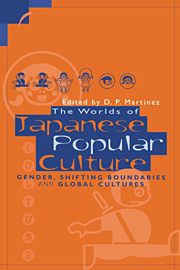Chapter 2 - Transformational Magic
Some Japanese super-heroes and monsters
Published online by Cambridge University Press: 22 September 2009
Summary
Introduction
In any culture, there are elements of change and elements of continuity (Ohnuki-Tierney 1987). The literature on Japan tends to over-emphasize either change (such as in technology) or continuity (for example, cherry blossom viewing, haiku, sumo, etc.). In this chapter, I hope to show how cultural continuities may be found even in an area of popular culture which is subject to countless fast-changing influences: commercial television dramas for children.
The makers of these programs are under constant pressure to respond to changing tastes, to maintain audience ratings, and to sell advertising and spin-off products. Yet a look at the programs reveals recurrent themes which, in some cases, have their roots in supernatural beliefs dating back to antiquity. In this chapter I shall discuss how some of these old beliefs find expression in the super-heroes and monsters of Japanese children's television. The very longevity of these themes and their shared symbolic similarities (as outlined below) suggest that they are of fundamental importance in Japanese culture.
Japan has seven national television networks, two public and five commercial, besides numerous local and satellite stations. At any given time there are likely to be some twenty to thirty assorted children's dramas in the viewing week, most of which disappear from the screens after a year or so, often to be replaced by something very similar.
- Type
- Chapter
- Information
- The Worlds of Japanese Popular CultureGender, Shifting Boundaries and Global Cultures, pp. 33 - 55Publisher: Cambridge University PressPrint publication year: 1998
- 4
- Cited by

